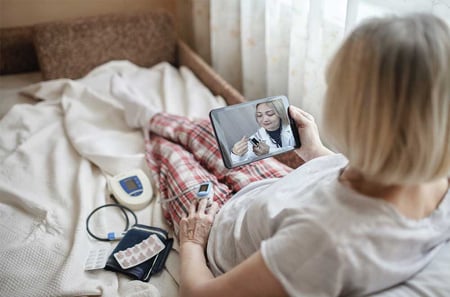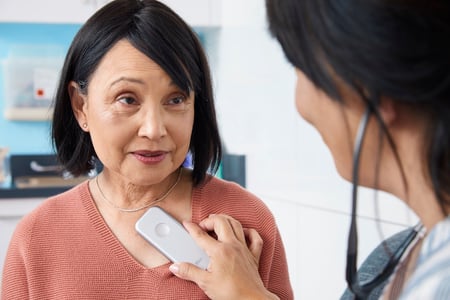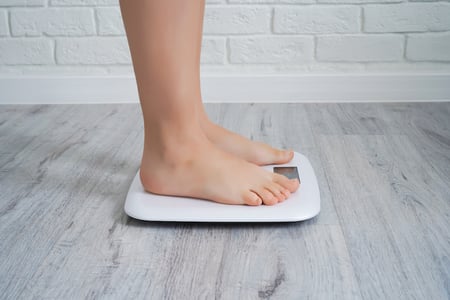Remote patient monitoring (RPM) devices allow providers to monitor, report, and analyze their patient’s acute or chronic conditions from outside the hospital or clinic setting. They enable real-time understanding of a patient’s disease state, enabling the provider to make proactive clinical decisions.
Remote patient monitoring devices help patients engage with and better understand their health daily. When a patient is engaging with their health daily through RPM devices they are more likely to see lasting positive health outcomes.
There are many remote patient monitoring devices available on today’s market. Below, learn more about 7 devices that we commonly see used in remote patient monitoring programs.
1. Blood Pressure Cuff
Blood pressure cuffs calculate a patient’s heart rate and blood flow by measuring changes in artery motion. The Bluetooth blood pressure cuff is similar to the one we’ve all used before at the doctor’s—the key difference is that it sends the data in real time to the clinician for review.
Blood pressure monitoring can assist with management of many conditions including hypertension, diabetes, CHF, and kidney dysfunction. Any condition with the symptom of hypertension, or high blood pressure, can benefit from at-home blood pressure monitoring. Day to day monitoring of blood pressure is beneficial because it offers insight into the day-to-day status of the heart, as opposed to a one point in time reading. It also helps avoid white coat hypertension where the patient’s blood pressure reading in the office is higher than it usually is at home. On the other side of the coin, daily blood pressure monitoring helps avoid masked hypertension, the scenario when a patient’s blood pressure is normal at the doctor’s office, but elevated at home.
2. Glucometer
Glucometers test a patient’s blood sugar through a small drop of blood placed on a test strip that is connected to the device. The patient places a small drop of blood on the test strip, which is read by the meter to produce the blood glucose reading. The reading is then sent in real-time to the provider for review.
Many patients with type 1 and type 2 diabetes use a glucometer daily, often multiple times a day to manage their blood sugar. The glucometer helps the patient and their provider understand how certain factors are influencing the patient’s blood sugar and diabetic symptoms. Factors include medication effects, diet, exercise, and stress or illness.
3. Pulse Oximeter
The pulse oximeter is a non-invasive clip that is attached to the patient’s finger (or occasionally earlobe) to measure light wavelengths that determine blood oxygen level—how much oxygen is circulating in the patient’s red blood cells. Additionally, the pulse oximeter records a patient’s pulse.
Pulse oximeters are used among patients with chronic conditions, including chronic heart or lung issues like COPD or CHF, and for COVID-19 screening and monitoring. They are also used for patients with pneumonia and asthma. Pulse oximeters help providers monitor changes in a patient’s lung function. For COVID-19 patients, for example, low-blood oxygen levels are often a key indicator of a positive diagnosis.

4. ECG + Stethoscope
An ECG captures heart function, while a stethoscope captures heart and lung sounds. The ECG is commonly used for patients with cardiac conditions like arrhythmias or coronary artery disease. The stethoscope amplifies the internal sounds of the body, enabling the provider to capture heart, lung, and bowel sounds.
Many HRS clients are using biometric monitoring devices to capture heart and lung sounds virtually. At home, the patient self-monitors and the ECG or stethoscope reading is then sent directly to the clinician to review—this can be done in real-time via virtual visits, or saved in the ClinicianConnect® portal for later clinical review. This allows providers to monitor their patient’s heart and lung sounds from afar, enabling early detection and more personalized care delivery.

Want to learn more about RPM devices? Get a free demo from the HRS team to learn how you can integrate these devices into a successful RPM program:
5. Wearables (Activity Trackers and Continuous Monitoring)
Activity trackers enable providers to track their patient’s steps, heart rate, fall risk, and even sleep. They offer the provider a window into the patient’s day-to-day routine, helping the provider understand how daily activities affect the patient’s health and symptoms. Providers are able to use the data from the activity to inform the patient’s treatment plan. Common activity trackers include the Fitbit or Apple Watch.
Some wearables enable continuous monitoring through a sticker or patch. Applied onto the patient’s body, these wearables facilitate ongoing symptom and biometric tracking. Wearables can track a patient’s heart rate, blood pressure, glucose, weight, and stress in one single device.
6. Thermometer
A Bluetooth thermometer provides a fast and accurate picture into the patient’s fever (body temperature) offering the provider essential information to inform the next steps of care.
There are many types of Bluetooth thermometers available on the market today, including non-touch digital thermometers that scan the forehead (temporal artery) and contact thermometers which most commonly are placed under the patient’s tongue for an accurate reading.
A fever is a key indicator of many conditions, including COVID-19, the flu, or other infections. For other conditions, a fever can be a sign of worsening or exacerbated symptoms.
7. Scale
Bluetooth scales enable the patient to track changes in their weight over time, and the provider to monitor those changes to ensure symptoms are not worsening, and if they are, intervene. For CHF patients especially, where weight fluctuations are often a result of water retention, this is essential. It is crucial that the provider is able to observe weight changes since weight gain is often one of the key indicators of worsening CHF.
For patients with obesity, bluetooth scales enable self-management, encouraging the patient to take responsibility and identify trends in their behavior. Obesity is a leading risk factor for many conditions—heart disease, stroke, type 2 diabetes, certain forms of cancer—so managing it closely is crucial.
Remote patient monitoring devices augment in-person care, allowing the provider to understand the full picture of their patient’s symptoms over time, as opposed to just at the in-person visit. They help providers do their jobs more efficiently, effectively, and in a more data-driven manner.
Remote patient monitoring devices help the patient engage in their health and understand trends in their condition, empowering them to be in the driver’s seat of their healthcare journey.
In today’s patient-centric healthcare climate, patient’s value convenience, and want to have healthcare delivery in their pockets. Across the country, healthcare organizations have risen to this challenge and have realized the many, many benefits of RPM.
Learn More About Remote Patient Monitoring
